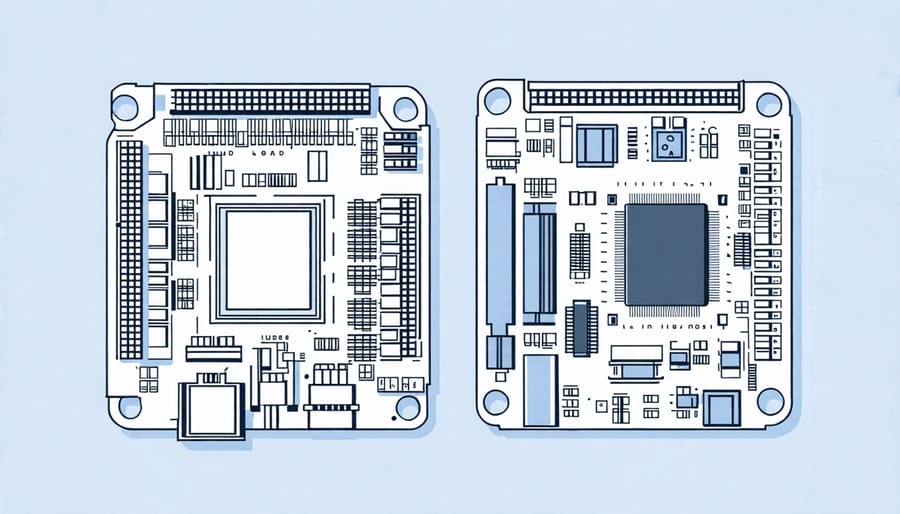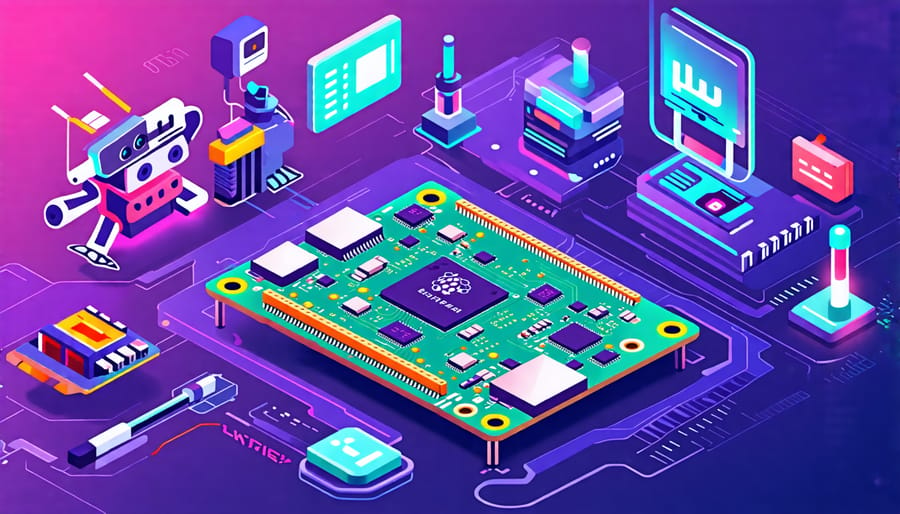Discover compute modules by exploring Raspberry Pi’s customizable solutions. Maximize your project’s efficiency by integrating compute modules into your designs, offering all the essential elements of a Raspberry Pi but in a flexible, embeddable format. Optimize space-constrained applications such as robotics, IoT devices, or industrial automation by leveraging the compact, powerful design of these modules. Experiment with upgrading existing projects; swap out traditional boards for compute modules to benefit from high-performance processing without altering your project’s blueprint. Encourage technological exploration in educational settings by introducing students to the versatility of compute modules, fostering hands-on learning through building custom computing solutions. With their adaptability and power, compute modules are your gateway to innovative projects, allowing boundless creativity and control over every aspect of your design.
What Exactly is a Compute Module?
Components of a Compute Module
A compute module is a compact and versatile piece of hardware that forms the brain of many computing projects, especially in the realm of Raspberry Pi innovations. At its core, you’ll find a powerful processor, memory, and often flash storage, all integrated to handle challenging computational tasks. For example, the Raspberry Pi Compute Module 3+ is equipped with a Broadcom processor that offers the power akin to a Raspberry Pi 3, making it ideal for tasks requiring considerable processing capability. Next to the processor, RAM is crucial for multitask efficiency and speedy data handling, commonly seen in sizes ranging from 512MB to several gigabytes in newer versions. Embedded flash storage allows for quick boot times and storage of essential files. These components work in harmony to execute everything from simple educational projects to complex automation tasks, empowering tech enthusiasts and educators to push the boundaries of innovation.
Compute Module vs. Raspberry Pi Boards
Compute Modules and traditional Raspberry Pi boards serve distinct purposes despite their shared foundation. The Raspberry Pi boards are renowned for their all-in-one design, offering ports like HDMI, USB, and Ethernet, making them ideal for quick setups or educational purposes. They’re perfect for beginners due to their plug-and-play nature, allowing users to dive straight into coding and project creation without additional components.
In contrast, Compute Modules provide a more flexible solution aimed at advanced users and industrial applications. Stripped-down to the essential computing power of a Raspberry Pi, they come without peripheral features, requiring integration into custom circuits or carrier boards. This design fosters scalability and innovation, suiting projects needing a tailored fit or multiple units.
In terms of performance, both options usually share similar processing capabilities, but Compute Modules shine in applications where size and customizability are critical. Whether you’re a hobbyist building IoT devices or an educator crafting bespoke solutions, understanding these differences ensures the optimal choice for your project needs.

Applications and Use Cases
Innovative Projects Using Compute Modules
Compute modules have sparked innovation across various fields, transforming concepts into tangible realities. From personalized laboratory tools to advanced environmental monitoring systems, these modules provide the flexibility and power required for a myriad of applications. For tech enthusiasts eager to tinker and educators aiming to inspire, a compute module project offers both challenge and reward. Take, for instance, the development of a solar-powered Raspberry Pi. This project utilizes a compute module to harness solar energy, offering an eco-friendly solution with practical implications for remote computing. Another noteworthy innovation is the creation of a compact and programmable smart mirror that integrates a compute module to deliver real-time information and updates, bringing futuristic technology into the household. Additionally, in the realm of robotics, compute modules serve as the brains behind sophisticated automation systems, offering agility and precision in an easily programmable package. These projects underscore the vast potential and versatility of compute modules, encouraging users to explore and innovate.

Why Choose a Compute Module for Your Next Project?
Choosing a compute module for your next project can unlock a range of benefits, particularly if you’re exploring Raspberry Pi-based ventures. One of the main advantages is their flexibility. Compute modules offer a compact and customizable solution, ideal for embedding into custom hardware where space is a premium. Tailored to fit specific needs, they allow for a seamless integration of processing power, memory, and connectivity, simplifying the design process.
Another key benefit is scalability. Compute modules can handle a variety of projects, from simple DIY electronics to more complex industrial applications, providing a versatile platform for growth. Not only do they support various peripheral connections thanks to their robust interface, but they also help minimize costs without sacrificing performance.
While compute modules are a powerful option, they aren’t without potential drawbacks. For beginners, the need for additional programming and configuration can present a learning curve. Moreover, the initial setup may require extra components, such as carriers or custom boards, which could increase the project’s complexity and upfront cost.
Despite these challenges, the long-term gains in learning and innovation are substantial. By embracing compute modules, tech enthusiasts and educators can delve into a future-ready approach, equipping themselves to craft sophisticated projects and IoT applications with confidence.
Getting Started with Compute Modules
Choosing the Right Compute Module
Selecting the right compute module for your Raspberry Pi project hinges on understanding your specific needs. Firstly, consider the power requirements and processing capabilities. If your project demands robust performance, like AI processing or server tasks, look for modules with higher RAM and a faster processor. For simpler tasks, an entry-level module should suffice.
Next, evaluate the available interfaces and connectivity. Projects requiring multiple peripheral connections, such as cameras or multiple USB devices, will benefit from modules that offer increased GPIO pins and MIPI lanes. Also, ensure the module supports the networking capabilities your project needs, such as Wi-Fi or Bluetooth.
Size and form factor are essential factors if your project has spatial constraints. Some modules offer compact designs without compromising on power, making them ideal for space-limited installations.
Finally, keep your budget in mind. While high-end modules deliver superior performance, they come at a higher cost. Balance the required features with your financial constraints to ensure you’re making a cost-effective choice.
Setup and Configuration
Setting up a compute module, like the Raspberry Pi Compute Module, is a straightforward process that opens up a world of possibilities for your projects. To start, you’ll need a development kit or custom board that supports the module. Begin by inserting the compute module into its slot, making sure it’s securely connected. Next, download the latest Raspberry Pi OS and flash it to an SD card using software like balenaEtcher. Once your OS is ready, insert the SD card into the board’s slot.
Connect peripherals such as a monitor via HDMI, a keyboard, and a mouse. Power up the board, and you should see the OS boot up. Once the system is running, connect it to Wi-Fi through the settings or use a wired Ethernet connection. For optimal use, make sure to regularly update the OS and packages using the command line. This ensures you have the latest features and security patches. Enjoy exploring and experimenting with your new setup, as compute modules offer expansive possibilities in robotics, automation, and IoT projects.

Security Considerations for Compute Modules
When incorporating compute modules into your tech projects, security should be a top priority. Compute modules, such as those from Raspberry Pi, offer fantastic flexibility and power, but they must be safeguarded to prevent unauthorized access and data breaches. Begin by ensuring your module’s firmware is up-to-date with the latest security patches. An outdated system can be an easy target for hackers. Furthermore, consider setting strong, unique passwords and employing encryption tools to protect sensitive data. Network security is equally essential; use firewalls and VPNs to shield your projects from external threats.
Be mindful of physical security too. Properly securing your devices and implementing security protocols can deter tampering and theft. Additionally, for Internet of Things (IoT) projects, mean it when you minimize data exposure. Limit access to your network and devices with secure authentication methods. Lastly, for more detailed guidelines, consult resources like Raspberry Pi security to further protect your compute module projects. By staying informed and implementing these strategies, you can significantly enhance the resilience and security of your projects, fostering a safe environment for innovative exploration and learning.
Conclusion
As we wrap up our exploration of compute modules, it’s clear that these tiny yet powerful components offer a versatile and customizable approach to creating innovative Raspberry Pi projects. Their modular nature provides flexibility, allowing you to tailor computing power to fit specific requirements of various applications, from lightweight prototypes to full-fledged industrial use cases. Whether you’re a tech enthusiast eager to experiment or an educator looking to inspire your students with hands-on learning, compute modules offer endless possibilities for creativity and problem-solving. Encouragingly, even if you’re just starting, these modules provide a supportive gateway into the intricate world of electronics and coding. We invite you to explore using a compute module in your next Raspberry Pi project and discover how it can elevate your ideas to new heights. As you embark on this journey, remember that the richness of innovation lies in experimentation and learning, paving the way for groundbreaking projects that push boundaries.


